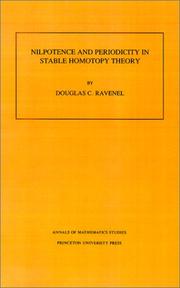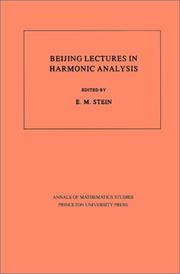| Listing 1 - 5 of 5 |
Sort by
|
Book
ISBN: 9782224034757 Year: 2016 Publisher: Paris : Editions Maloine,
Abstract | Keywords | Export | Availability | Bookmark
 Loading...
Loading...Choose an application
- Reference Manager
- EndNote
- RefWorks (Direct export to RefWorks)
Les médicaments et les modalités de prescription évoluent rapidement. Beaucoup d'internes, de jeunes médecins et même parfois de plus aguerris hésitent au moment de rédiger une ordonnance et les recommandations qui l'accompagnent. Pour leur offrir une aide pratique immédiate, une équipe de spécialistes a mis au point un ensemble d'ordonnances commentées correspondant à des situations cliniques fréquentes. Rédigées en DCI, de façon précise, avec les posologies, les contre-indications et les précautions d'emploi, elles constituent un aide-mémoire précieux pour tous ceux, médecins, pharmaciens, infirmières, étudiants, qui sont amenés à prescrire ou à surveiller un traitement.
Medicine --- Prescription writing --- Médecine --- Ordonnances médicales --- Formulae, receipts, prescriptions --- Formules et recettes --- Rédaction
Book
ISBN: 9780812247589 9780812224528 Year: 2016 Publisher: Philadelphia, Pa University of Pennsylvania Press
Abstract | Keywords | Export | Availability | Bookmark
 Loading...
Loading...Choose an application
- Reference Manager
- EndNote
- RefWorks (Direct export to RefWorks)
For a significant part of the early modern period, England was the most active site of recipe publication in Europe and the only country in which recipes were explicitly addressed to housewives. Recipes for Thought analyzes, for the first time, the full range of English manuscript and printed recipe collections produced over the course of two centuries.Recipes reveal much more than the history of puddings and pies: they expose the unexpectedly therapeutic, literate, and experimental culture of the English kitchen. Wendy Wall explores ways that recipe writing—like poetry and artisanal culture—wrestled with the physical and metaphysical puzzles at the center of both traditional humanistic and emerging "scientific" cultures. Drawing on the works of Shakespeare, Spenser, Jonson, and others to interpret a reputedly "unlearned" form of literature, she demonstrates that people from across the social spectrum concocted poetic exercises of wit, experimented with unusual and sometimes edible forms of literacy, and tested theories of knowledge as they wrote about healing and baking. Recipe exchange, we discover, invited early modern housewives to contemplate the complex components of being a Renaissance "maker" and thus to reflect on lofty concepts such as figuration, natural philosophy, national identity, status, mortality, memory, epistemology, truth-telling, and matter itself. Kitchen work, recipes tell us, engaged vital creative and intellectual labors.
History of civilization --- anno 1600-1699 --- anno 1500-1599 --- Great Britain --- Food writing --- Cooking, English --- Formulas, recipes, etc. --- Medicine --- Knowledge, Sociology of --- Renaissance --- History --- Formulae, receipts, prescriptions --- History.

ISBN: 069108792X 069102572X 1400882486 9780691025728 9780691087924 Year: 2016 Volume: 128 Publisher: Princeton, NJ : Princeton University Press,
Abstract | Keywords | Export | Availability | Bookmark
 Loading...
Loading...Choose an application
- Reference Manager
- EndNote
- RefWorks (Direct export to RefWorks)
Nilpotence and Periodicity in Stable Homotopy Theory describes some major advances made in algebraic topology in recent years, centering on the nilpotence and periodicity theorems, which were conjectured by the author in 1977 and proved by Devinatz, Hopkins, and Smith in 1985. During the last ten years a number of significant advances have been made in homotopy theory, and this book fills a real need for an up-to-date text on that topic. Ravenel's first few chapters are written with a general mathematical audience in mind. They survey both the ideas that lead up to the theorems and their applications to homotopy theory. The book begins with some elementary concepts of homotopy theory that are needed to state the problem. This includes such notions as homotopy, homotopy equivalence, CW-complex, and suspension. Next the machinery of complex cobordism, Morava K-theory, and formal group laws in characteristic p are introduced. The latter portion of the book provides specialists with a coherent and rigorous account of the proofs. It includes hitherto unpublished material on the smash product and chromatic convergence theorems and on modular representations of the symmetric group.
Homotopie --- Homotopy theory --- Homotopy theory. --- Deformations, Continuous --- Topology --- Abelian category. --- Abelian group. --- Adams spectral sequence. --- Additive category. --- Affine space. --- Algebra homomorphism. --- Algebraic closure. --- Algebraic structure. --- Algebraic topology (object). --- Algebraic topology. --- Algebraic variety. --- Algebraically closed field. --- Atiyah–Hirzebruch spectral sequence. --- Automorphism. --- Boolean algebra (structure). --- CW complex. --- Canonical map. --- Cantor set. --- Category of topological spaces. --- Category theory. --- Classification theorem. --- Classifying space. --- Cohomology operation. --- Cohomology. --- Cokernel. --- Commutative algebra. --- Commutative ring. --- Complex projective space. --- Complex vector bundle. --- Computation. --- Conjecture. --- Conjugacy class. --- Continuous function. --- Contractible space. --- Coproduct. --- Differentiable manifold. --- Disjoint union. --- Division algebra. --- Equation. --- Explicit formulae (L-function). --- Functor. --- G-module. --- Groupoid. --- Homology (mathematics). --- Homomorphism. --- Homotopy category. --- Homotopy group. --- Homotopy. --- Hopf algebra. --- Hurewicz theorem. --- Inclusion map. --- Infinite product. --- Integer. --- Inverse limit. --- Irreducible representation. --- Isomorphism class. --- K-theory. --- Loop space. --- Mapping cone (homological algebra). --- Mathematical induction. --- Modular representation theory. --- Module (mathematics). --- Monomorphism. --- Moore space. --- Morava K-theory. --- Morphism. --- N-sphere. --- Noetherian ring. --- Noetherian. --- Noncommutative ring. --- Number theory. --- P-adic number. --- Piecewise linear manifold. --- Polynomial ring. --- Polynomial. --- Power series. --- Prime number. --- Principal ideal domain. --- Profinite group. --- Reduced homology. --- Ring (mathematics). --- Ring homomorphism. --- Ring spectrum. --- Simplicial complex. --- Simply connected space. --- Smash product. --- Special case. --- Spectral sequence. --- Steenrod algebra. --- Sub"ient. --- Subalgebra. --- Subcategory. --- Subring. --- Symmetric group. --- Tensor product. --- Theorem. --- Topological space. --- Topology. --- Vector bundle. --- Zariski topology.

ISBN: 0691084181 069108419X 1400882095 Year: 2016 Publisher: Princeton, NJ : Princeton University Press,
Abstract | Keywords | Export | Availability | Bookmark
 Loading...
Loading...Choose an application
- Reference Manager
- EndNote
- RefWorks (Direct export to RefWorks)
Based on seven lecture series given by leading experts at a summer school at Peking University, in Beijing, in 1984. this book surveys recent developments in the areas of harmonic analysis most closely related to the theory of singular integrals, real-variable methods, and applications to several complex variables and partial differential equations. The different lecture series are closely interrelated; each contains a substantial amount of background material, as well as new results not previously published. The contributors to the volume are R. R. Coifman and Yves Meyer, Robert Fcfferman,Carlos K. Kenig, Steven G. Krantz, Alexander Nagel, E. M. Stein, and Stephen Wainger.
Harmonic analysis. --- Analysis (Mathematics) --- Functions, Potential --- Potential functions --- Banach algebras --- Calculus --- Mathematical analysis --- Mathematics --- Bessel functions --- Fourier series --- Harmonic functions --- Time-series analysis --- Analytic function. --- Asymptotic formula. --- Bergman metric. --- Bernhard Riemann. --- Bessel function. --- Biholomorphism. --- Boundary value problem. --- Bounded mean oscillation. --- Bounded operator. --- Boundedness. --- Cauchy's integral formula. --- Characteristic function (probability theory). --- Characterization (mathematics). --- Coefficient. --- Commutator. --- Complexification (Lie group). --- Continuous function. --- Convolution. --- Degeneracy (mathematics). --- Differential equation. --- Differential operator. --- Dirac delta function. --- Dirichlet problem. --- Equation. --- Estimation. --- Existence theorem. --- Existential quantification. --- Explicit formula. --- Explicit formulae (L-function). --- Fatou's theorem. --- Fourier analysis. --- Fourier integral operator. --- Fourier transform. --- Fredholm theory. --- Fubini's theorem. --- Function (mathematics). --- Functional calculus. --- Fundamental solution. --- Gaussian curvature. --- Hardy space. --- Harmonic function. --- Harmonic measure. --- Heisenberg group. --- Hilbert space. --- Hilbert transform. --- Hodge theory. --- Holomorphic function. --- Hyperbolic partial differential equation. --- Hölder's inequality. --- Infimum and supremum. --- Integration by parts. --- Interpolation theorem. --- Intersection (set theory). --- Invertible matrix. --- Isometry group. --- Laplace operator. --- Laplace's equation. --- Lebesgue measure. --- Linear map. --- Lipschitz continuity. --- Lipschitz domain. --- Lp space. --- Mathematical induction. --- Mathematical physics. --- Maximal function. --- Maximum principle. --- Measure (mathematics). --- Newtonian potential. --- Non-Euclidean geometry. --- Number theory. --- Operator theory. --- Oscillatory integral. --- Parameter. --- Partial derivative. --- Partial differential equation. --- Polynomial. --- Power series. --- Product metric. --- Radon–Nikodym theorem. --- Riemannian manifold. --- Riesz representation theorem. --- Scientific notation. --- Several complex variables. --- Sign (mathematics). --- Simultaneous equations. --- Singular function. --- Singular integral. --- Sobolev space. --- Square (algebra). --- Statistical hypothesis testing. --- Stokes' theorem. --- Support (mathematics). --- Tangent space. --- Tensor product. --- Theorem. --- Trigonometric series. --- Uniformization theorem. --- Variable (mathematics). --- Vector field.
Book
ISBN: 1400883849 Year: 2016 Publisher: Princeton, NJ : Princeton University Press,
Abstract | Keywords | Export | Availability | Bookmark
 Loading...
Loading...Choose an application
- Reference Manager
- EndNote
- RefWorks (Direct export to RefWorks)
When this book was written, methods of algebraic topology had caused revolutions in the world of pure algebra. To clarify the advances that had been made, Cartan and Eilenberg tried to unify the fields and to construct the framework of a fully fledged theory. The invasion of algebra had occurred on three fronts through the construction of cohomology theories for groups, Lie algebras, and associative algebras. This book presents a single homology (and also cohomology) theory that embodies all three; a large number of results is thus established in a general framework. Subsequently, each of the three theories is singled out by a suitable specialization, and its specific properties are studied. The starting point is the notion of a module over a ring. The primary operations are the tensor product of two modules and the groups of all homomorphisms of one module into another. From these, "higher order" derived of operations are obtained, which enjoy all the properties usually attributed to homology theories. This leads in a natural way to the study of "functors" and of their "derived functors." This mathematical masterpiece will appeal to all mathematicians working in algebraic topology.
Homology theory. --- Abelian group. --- Additive group. --- Algebra homomorphism. --- Algebraic topology. --- Anticommutativity. --- Associative algebra. --- Associative property. --- Axiom. --- Betti number. --- C0. --- Category of modules. --- Change of rings. --- Cohomology. --- Cokernel. --- Commutative diagram. --- Commutative property. --- Commutative ring. --- Cyclic group. --- Derived functor. --- Diagram (category theory). --- Differential operator. --- Direct limit. --- Direct product. --- Direct sum of modules. --- Direct sum. --- Duality (mathematics). --- Endomorphism. --- Epimorphism. --- Equivalence class. --- Exact category. --- Exact sequence. --- Existential quantification. --- Explicit formulae (L-function). --- Factorization. --- Field of fractions. --- Finite group. --- Finitely generated module. --- Free abelian group. --- Free monoid. --- Functor. --- Fundamental group. --- G-module. --- Galois theory. --- Global dimension. --- Graded ring. --- Group algebra. --- Hereditary ring. --- Hochschild homology. --- Homological algebra. --- Homology (mathematics). --- Homomorphism. --- Homotopy. --- Hyperhomology. --- I0. --- Ideal (ring theory). --- Inclusion map. --- Induced homomorphism. --- Injective function. --- Injective module. --- Integral domain. --- Inverse limit. --- Left inverse. --- Lie algebra. --- Linear differential equation. --- Mathematical induction. --- Maximal ideal. --- Module (mathematics). --- Monoidal category. --- Natural transformation. --- Noetherian ring. --- Noetherian. --- Permutation. --- Polynomial ring. --- Pontryagin duality. --- Product topology. --- Projective module. --- Quotient algebra. --- Quotient group. --- Quotient module. --- Right inverse. --- Ring (mathematics). --- Ring of integers. --- Separation axiom. --- Set (mathematics). --- Special case. --- Spectral sequence. --- Subalgebra. --- Subcategory. --- Subgroup. --- Subring. --- Summation. --- Tensor product. --- Theorem. --- Topological space. --- Topology. --- Trivial representation. --- Unification (computer science). --- Universal coefficient theorem. --- Variable (mathematics). --- Zero object (algebra).
| Listing 1 - 5 of 5 |
Sort by
|

 Search
Search Feedback
Feedback About UniCat
About UniCat  Help
Help News
News